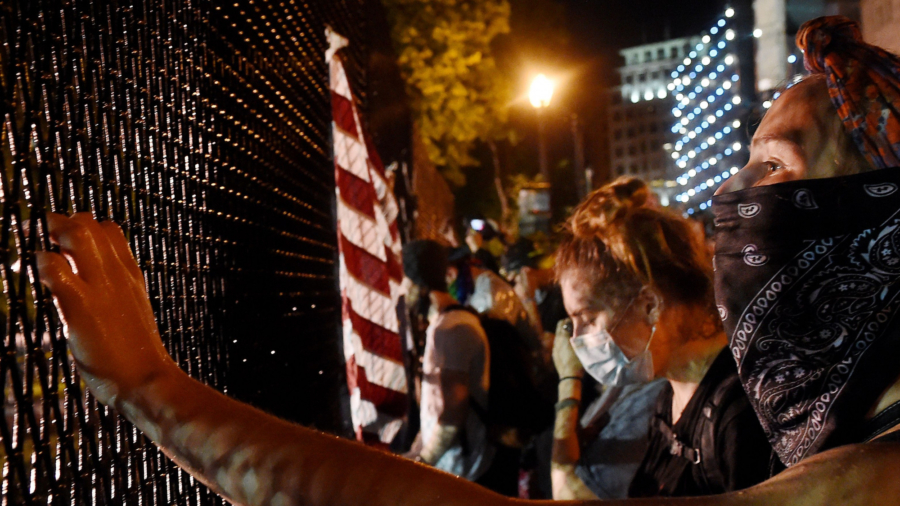The American Civil Liberties Union (ACLU) and other groups filed a lawsuit on behalf of Black Lives Matter and a number of individuals against the Trump administration on Thursday, alleging that officials had violated the civil rights of protesters by carrying out law enforcement measures to disperse crowds of protesters near the White House on June 1.
Protesters were removed from a park on June 1 around 6:30 p.m. near the White House, with police employing smoke bombs and pepper balls, ahead of a 7 p.m. to 6 a.m. curfew imposed by Washington Mayor Muriel Bowser.
Around 7:00 p.m., President Donald Trump made his way across the park—Lafayette Square—from the White House to St. John’s Church and held up a bible.


The short trip to the church and back to the White House—accompanied by senior aides, along with Secret Service agents and reporters—came after Trump announced at a news conference that he was deploying military personnel and other federal assets to quell violent activities in Washington.
In a statement, the ACLU characterized police measures to evacuate the protesters from the area as a “coordinated and unprovoked charge into the crowd of demonstrators.”
The lawsuit (pdf), filed in federal court on Washington, alleged that Trump and Attorney General William Barr “[ordered] the use of violence against peaceful demonstrators who were speaking out against discriminatory police brutality targeted at Black people.”
The lawsuit was filed on behalf of the group Black Lives Matter D.C. and individual protesters who were present. It is filed by the ACLU of the District of Columbia, Washington Lawyers’ Committee for Civil Rights and Urban Affairs, Lawyers’ Committee for Civil Rights Under Law, and the law firm of Arnold & Porter.
“On June 1, 2020, a group of demonstrators, including Plaintiffs, gathered peacefully in Lafayette Square to protest the gross, systemic injustices perpetrated by law enforcement against Black people in the United States,” the lawsuit reads.
It later adds, “Without provocation, Defendants directed their agents in the U.S. Secret Service, U.S. Park Police, D.C. National Guard, and U.S. Military Police to fire tear gas, pepper spray capsules, rubber bullets and flash bombs into the crowd to shatter the peaceful gathering, forcing demonstrators to flee the area. Many peaceful demonstrators were injured, some severely, by this unprovoked attack.”

According to the version of events from U.S. Park Police acting Chief Gregory T. Monahan, around 6:30 p.m. on June 1, “violent protesters” had become “more combative,” “attempted to grab officers’ weapons,” and “continued to throw projectiles” that included “bricks, frozen water bottles, and caustic liquids.” It was after such actions that police deployed smoke canisters and pepper balls to help them evacuate demonstrators from the area, he said in a June 2 statement. He also denied the claim that officers used tear gas.
Police officers had also found “caches of glass bottles, baseball bats, and metal poles hidden along the street,” and that “intelligence had revealed calls for violence against the police,” according to Monahan. To stop the violence, the USPP followed “established policy” and issued three warnings over a loudspeaker telling the demonstrators on H Street to leave the area, Monahan said.

Barr said on Thursday that he had met with other law enforcement officials earlier on June 1 and decided they needed to extend a security perimeter around the White House to protect federal agents “who could be reached by projectiles from the street,” The Associated Press reported.
He said that he expected the perimeter to be moved in the early afternoon, but when he arrived in the evening, he learned it wasn’t done and ordered law enforcement officials to take action, according to the AP. Barr added that police asked the protesters to leave the area multiple times and only took action when the crowd refused to leave.
On Friday, Barr told the AP that he did not give officers a tactical order to disperse the crowd, though he supported the decision of the officers to push back protesters, which was already unfolding when he arrived there Monday evening.
White House counselor Kellyanne Conway told reporters on June 2 that “[t]here was a plan to expand the perimeter from H Street to I Street based on the events as they had unfolded the night before.”

Floyd died after a Minneapolis police officer knelt on his neck for nearly nine minutes during an arrest on May 25. Floyd’s death and the events leading to it sparked nationwide protests expressing grief over police brutality. But in many instances, acts of violence, arson, and looting have marred the initially peaceful demonstrations.


Federal officials, including Attorney General William Barr, say they believe such violent activities have been spurred and coordinated by outside agitators and radicals.
Trump on June 1 announced that his administration will designate Antifa as a terrorist group. Short for anti-fascists, Antifa is an umbrella term for far-left-leaning groups that seek to use violence to silence their opponents.
Trump also praised the National Guard for shutting down the chaos in Minneapolis that he said was steered by “ANTIFA led anarchists, among others.”
“I want the organizers of this terror to be on notice that you will face severe criminal penalties and lengthy sentences in jail. This includes Antifa and others who are leading instigators of this violence,” Trump said at the time.
Amid violent activities across the nation, the National Guard has been deployed in at least 29 U.S. states at the request of governors, and the Pentagon has moved about 1,600 troops into the Washington area.
The Associated Press contributed to this report.
From The Epoch Times


